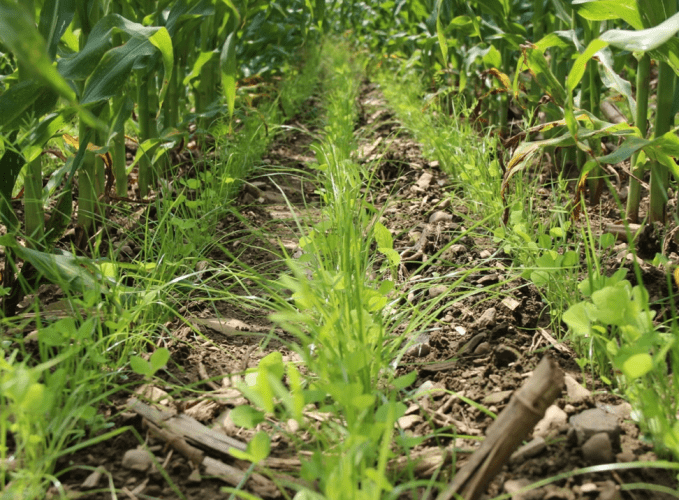
Grass and legume cover crop mixture interseeded into corn | Photo: Chris Pelzer
By Matt Ryan
Soil conservation is catching on as more farmers are planting cover crops on more of their land. Data from the 2017 Census of Agriculture show that farmers in New York are making significant strides towards sustainability. Compared to 2012, 605 more farmers in New York planted cover crops, protecting and improving an additional 80,136 acres of land. That’s a 16% increase in the number of New York farmers planting cover crops and a 37% increase in the acres planted with cover crops from 2012 to 2017.
Farmer interest and enthusiasm for cover crops and soil health is at an all-time high. One factor contributing to these increases is assistance that farmers are getting with cover crops from cooperative extension, industry, and other organizations. With funding from the New York State Environmental Protection Fund, the New York Soil Health Initiative was started in 2016 and brings together farmers, researchers, and agricultural service providers to facilitate the adoption of practices that improve soil health. During the first year, the New York Soil Health Initiative partnered with another new organization, the Northeast Cover Crops Council, to host the first annual Northeast Cover Crops Conference at Cornell University.
Increasing evidence shows that cover crops can make a big difference in crop performance, especially when it comes to extreme weather. For example, this spring was extremely wet and fields that had a history of cover crops were better able to handle the wet conditions than fields that were not cover-cropped. In addition to keeping the soil covered and protecting against erosion, cover crops pull carbon dioxide from the atmosphere and store it in the soil as organic matter, thus helping to reduce greenhouse gases. Cover crops also improve soil heath by supporting beneficial soil microorganisms, increasing soil aggregate stability, and improving water infiltration into the soil. Combined, these effects from cover crops add up and increase the resilience of cropping systems to extreme weather events such as heavy rain as well as short-term droughts.
By working together with different organizations, farmers are overcoming past obstacles and learning how to maximize the benefits of cover crops while minimizing costs and potential risks.
One challenge with winter cover crops is getting them established after crops are harvested. Numerous surveys have consistently shown that one of the main barriers to adoption is that farmers do not have enough time to plant cover crops in the fall after their main crops are harvested. Innovative farmers, like Donn Branton in western New York, are interseeding cover crops into corn and soybean in the summer, which saves time in the fall and allows the cover crops more time to grow and provide benefits.
Cover crop mixtures are also being used by more farmers. Different cover crops provide different benefits, and by planting multiple cover crop species together farmers can maximize the return on their investment. For example, by planting grass cover crops that reduce nutrient leaching such as cereal rye, oats, or annual ryegrass along with legume cover crops that fix atmospheric nitrogen and make it available to plants, such as red clover, winter pea, or hairy vetch, farmers can decrease fertilizer requirements in subsequent crops. Most companies that sell cover crop seed now offer mixtures designed for specific purposes. Research is also being conducted in New York to increase cover crop variety options and breed cover crops for different traits, such as winter hardiness, which can further increase their utility and the benefits that they provide.
Although more work is needed, cover crops are emerging as a key tool that farmers can use to address a variety of problems and increase the sustainability of their operations. Resources to help farmers in New York navigate decisions about cover crops and other soil building practices, as well as ways to increase farm resilience to extreme weather can be found at theses websites:
Cover Crop Guide for New York Vegetable Growers
Cornell Small Farms Program: Cover Crops
NRCS-NY: Cover Crops – Keeping Soil in Place While Providing Other Benefits
This story originally appeared in the New York Farm Bureau Grassroots Newspaper.